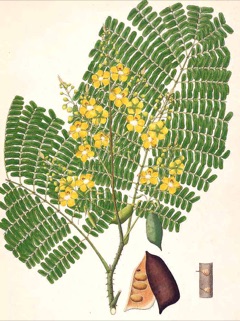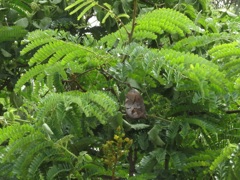 |
|
edibleplants.org |
 |
| wikimedia.org/wiki/User:Forestowlet |
Translate this page:
Summary
A small, prickly, straggling tree
Physical Characteristics

 Caesalpinia sappan is an evergreen Tree growing to 7 m (23ft) by 7 m (23ft) at a fast rate.
Caesalpinia sappan is an evergreen Tree growing to 7 m (23ft) by 7 m (23ft) at a fast rate.
See above for USDA hardiness. It is hardy to UK zone 10.
It can fix Nitrogen.
Suitable for: light (sandy), medium (loamy) and heavy (clay) soils and prefers well-drained soil. Suitable pH: mildly acid, neutral and basic (mildly alkaline) soils. It cannot grow in the shade. It prefers dry or moist soil.
UK Hardiness Map
US Hardiness Map
Synonyms
Biancaea sappan (L.) Tod.
Habitats
Edible Uses
A few drops of wood extract in drinking water is considered refreshing, due to the fragrance and colour it imparts[299 ]. The dye obtained from the wood is sometimes used to colour food[299 ].
References More on Edible Uses
Medicinal Uses
Plants For A Future can not take any responsibility for any adverse effects from the use of plants. Always seek advice from a professional before using a plant medicinally.
Dysentery
Sappanwood is used in the traditional medicines of various Asiatic countries[299 ]. Modern research has identified various medically active compounds in the plant, particularly brazilin, which is found in the heartwood[299 ]. Brazilin has been shown to have a positive effect on the immune functions; plus a hypoglycaemic action and increased glucose metabolism[299 ]. A decoction of the wood has shown antibiotic activity against Staphylococcus, Salmonella typhi, Shigella flexneri, Shigella dysenteriae and Bacillus subtilis. An extract of Caesalpinia sappan was found to be a potent agent for inactivating human sperm in vitro; about 2.5 mg/ml is required to reduce motility to 50%[299 ]. A decoction or infusion of the heartwood is generally considered a strong emmenagogue and astringent. It is also used to cure wounds (also with a plaster of macerated leaves and bark), tuberculosis, diarrhoea and dysentery and is reported as having antioxidant, anti-inflammatory, hepatoprotective, cytotoxic, hypoglycaemic and xanthine oxidase-inhibitory activities[299 ]. The seeds serve as a sedative[299 ].
References More on Medicinal Uses
Now available: PLANTS FOR YOUR FOOD FOREST: 500 Plants for Temperate Food Forests and Permaculture Gardens.
An important new book from PFAF. It focuses on the attributes of plants suitable for food forests, what each can contribute to a food forest ecosystem, including carbon sequestration, and the kinds of foods they yield. The book suggests that community and small-scale food forests can provide a real alternative to intensive industrialised agriculture, and help to combat the many inter-related environmental crises that threaten the very future of life on Earth.
Read More
Other Uses
Agroforestry Uses: The tree is often planted as a living fence. Owing to its easy growth and dense growth habit, it is used for defining the boundaries of land and for protecting plantations against grazing animals[299 ]. Other Uses A red dye is obtained from the wood[[46 , 299 ]. Silk, wool, cotton, matting and basket fibres can be dyed with it[299 ]. The wood is ground into a coarse powder, moistened with water and allowed to ferment for a few weeks to increase the colouring power of the dye[299 ]. It is then boiled in water and the liquid can either be used immediately or evaporated and stored as a dry soluble extract for future use[299 ]. The mordants used (e.g. aluminium acetate, stannic salts, oxalic acid) determine the final colour of the cloth, which can vary from shades of red to pink, violet and brown[299 ]. A yellow dye is obtained from the bark[598 ]. The fruits contain tannin and were used in the past to prepare a black dye in combination with an iron mordant[299 ]. The seedpods are used, like those of several other related species, together with protosulphate of iron, to make an ink or black dye[459 ]. The leaves can be used to hasten ripening of fruits such as bananas and mangoes[299 ]. A gum is obtained from the stem[303 ]. The leaves contain a pleasant smelling volatile oil[303 ]. The wood is straight grained with a fine to moderately fine texture, fairly heavy, hard and lustrous[299 ]. It is difficult to dry and is susceptible to warping and collapse, but moderately easy to work; it takes a high finish, and is tough and resistant to termite attack[299 ]. It has been used in cabinet-making since mediaeval times, especially for inlay decoration[299 ]. It is often used for carving[598 ]. The wood is also is a good source of firewood[299 ].
Special Uses
Carbon Farming
References More on Other Uses
Cultivation details
Industrial Crop: Dye Management: Coppice Regional Crop
Sappanwood succeeds in semi-arid to moist tropical regions. It tolerates an annual precipitation in the range 700 - 4,300 mm and a mean annual temperature of 24 - 28c[299 ]. Succeeds in any moderately fertile, well-drained soil[200 ]. Young plants are best grown in the shade of trees in the forest or in forest borders[299 ], but older trees require a position in full sun[200 ]. Succeeds in a pH of 5 - 7.5[299 ]. Flowering can occur after 1 year of growth and usually during the rainy season, fruiting about 6 months later[303 ]. Plants respond well to coppicing[299 ]. The tree is cut about 1 metre above the ground to allow sprouts to grow from the stump[299 ]. Harvesting is done manually with a machete; prickles are easily removed by brushing with the blunt edge of the machete[299 ]. For use as a dyewood the tree must be harvested every 6 - 8 years, to allow the heartwood to become fully developed; for firewood it may be harvested every 3 - 4 years when the trunk has attained a diameter of 5 - 6 cm[299 ]. Plants in this genus are notably resistant to honey fungus[200 ]. This species has a symbiotic relationship with certain soil bacteria, these bacteria form nodules on the roots and fix atmospheric nitrogen. Some of this nitrogen is utilized by the growing plant but some can also be used by other plants growing nearby[200 ].
Carbon Farming
-
Industrial Crop: Dye
Botanical dyes replacing synthetic dyes (known as heavy polluters).
-
Management: Coppice
Cut to the ground repeatedly - resprouting vigorously. Non-destructive management systems maintaining the soil organic carbon.
-
Regional Crop
These crops have been domesticated and cultivated regionally but have not been adopted elsewhere and are typically not traded globally, Examples in this broad category include perennial cottons and many nuts and staple fruits.
References Carbon Farming Information and Carbon Sequestration Information
Temperature Converter
Type a value in the Celsius field to convert the value to Fahrenheit:
Fahrenheit:
The PFAF Bookshop
Plants For A Future have a number of books available in paperback and digital form. Book titles include Edible Plants, Edible Perennials, Edible Trees, and Woodland Gardening. Our new book to be released soon is Edible Shrubs.
Shop Now
Propagation
Seed - pre-soak for 12 - 24 hours in warm water prior to sowing. The seed usually germinates within a few days[299 ]. When large enough to handle, prick the seedlings out into individual pots and grow them on until large enough to plant out. Softwood cuttings in sand in a frame[200 ].
Other Names
If available other names are mentioned here
Bakam, Pattangi, Beys fathangu, Maikpan, Pohon secang, Pohon soga jawa, Sunthe, Teinnyet, Tomoc, Vang, Vang nhuom
Native Plant Search
Search over 900 plants ideal for food forests and permaculture gardens. Filter to search native plants to your area. The plants selected are the plants in our book 'Plants For Your Food Forest: 500 Plants for Temperate Food Forests and Permaculture Gardens, as well as plants chosen for our forthcoming related books for Tropical/Hot Wet Climates and Mediterranean/Hot Dry Climates. Native Plant Search
Found In
Countries where the plant has been found are listed here if the information is available
Asia, Cambodia, China, India, Indochina, Indonesia, Laos, Malaysia, Maldives, Myanmar, North America, SE Asia, Sri Lanka, Thailand, USA, Vietnam.
Weed Potential
Right plant wrong place. We are currently updating this section.
Please note that a plant may be invasive in one area but may not in your area so it’s worth checking.
Conservation Status
IUCN Red List of Threatened Plants Status : Status: Lower Risk/least concern

Growth: S = slow M = medium F = fast. Soil: L = light (sandy) M = medium H = heavy (clay). pH: A = acid N = neutral B = basic (alkaline). Shade: F = full shade S = semi-shade N = no shade. Moisture: D = dry M = Moist We = wet Wa = water.

Expert comment
Author
L.
Botanical References
Links / References
For a list of references used on this page please go here
A special thanks to Ken Fern for some of the information used on this page.
Readers comment
| Add a comment |
|
If you have important information about this plant that may help other users please add a comment or link below. Only comments or links that are felt to be directly relevant to a plant will be included. If you think a comment/link or information contained on this page is inaccurate or misleading we would welcome your feedback at [email protected]. If you have questions about a plant please use the Forum on this website as we do not have the resources to answer questions ourselves.
* Please note: the comments by website users are not necessarily those held by PFAF and may give misleading or inaccurate information.
To leave a comment please Register or login here All comments need to be approved so will not appear immediately.
|
Subject : Caesalpinia sappan
|
|
|
|